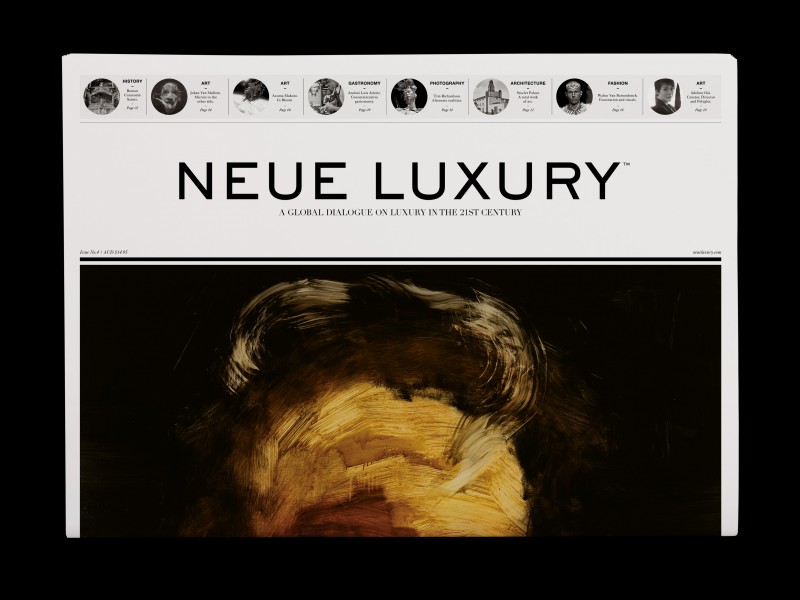Two years ago contemporary Chinese art dealer and collector Judith Neilson offered furniture designer Khai Liew perhaps the biggest private commission in Australia: 190 pieces, including a sixteen metre dining table made from Brazilian cherry wood. Sixty hand-carved dining chairs, rugs, standard lamps and table lighting, made without any aesthetic or financial restrictions, make up what is collectively named Indigo Slam. Precedents exist, of course. Liew compares it to banker and art collector Adolphe Stoclet commissioning architect Josef Hoffmann of the ‘Vienna Workshop’ and the ‘Vienna Secession’ movement, to build a total work of art for his house, The Stoclet Palace, between 1905 and 1911.
But then Khai Liew has an ingrained interest in historical precedents. For the past eighteen years his studio has established a reputation for beautifully crafted furniture, which draws on international styles from across all eras. Ancient Egyptian chairs, 14th century linenfold, Shaker austerity, 19th century arts and craft, and Chinese and Japanese construction techniques may be called into service at any time. Yet despite this postmodern layering, Liew’s style tends toward the modernist reduction epitomised by Scandinavian design.
To commission a complete collection from one designer ascribes in many ways to a “traditional sense of luxury,” he acknowledges. “It’s luxury goods, but at the same time the secret of this is that it doesn’t look like ‘rich people’s’ furniture.
“I’ve always felt that all the work we do has to have a humility to it. It shouldn’t be about my ego or making grand gestures. It just has to be about beauty and capturing beauty in form.”
Aside from the obvious grandeur of a sixteen metre long table, the collection needn’t look grand; it just has to feel like it’s part of the home, he says, “It has to be domesticated. It has to be comfortable; the material has to have good haptic qualities. Anything like wood, wools and fibre all have domestic qualities to them.”
“If materiality naturally provides the heart of the finely crafted furniture, it’s guided by a governing philosophy,” Liew explains. Above the entrance to his Adelaide workshop are two posters. One carries an old Islamic saying: ‘Beauty is goodness written in matter.’ The other carries three words: ‘Domesticity’, ‘Spirituality’ and ‘Humility’.
“My cabinetmakers see these two posters as they come in to remind themselves of the kind of work that’s required from the workshop,” he says. “I’ve always tried to instil what we term, unconscious beauty—beauty that’s not always apparent. It doesn’t strive to be beautiful—it has to be pure. My idea of beauty is purity. And it has to transcend the material. It has to be spiritual as well.”
Where better to begin than with light? Working on Neilson’s commission for the last two years has been an exercise in “capturing light on a piece of furniture,” Liew explains. “It’s an exploration of how I can shape a leg and in that process capture light on the particular curve or angle.”
As with all his work, however, it’s about telling a story—“it has to have a life of its own”. Liew may baulk at the grand gesture, but the ambition is evident. He wants the Indigo Slam collection to embody “the story about where we are now in Australia in terms of decorative arts … I’ve always thought that a piece of furniture is a window into a culture at any point in history,” he explains.
At a time when critics question whether in fact we need yet another chair, let alone a whole collection, Liew contends that each generation must design to claim their own moment in history. “One hundred years from now someone can look back and say that particular work defined that time.”
Khai Liew’s dedicated design approach is predicated on a series of happy accidents. He became an expert in colonial furniture by collecting and restoring it simply to finance his university education. As a Chinese-Malaysian immigrant it was also a convenient way to learn about Australian culture. “It took me to country towns and auctions and the back streets of Tasmania,” he remembers. “The furniture was unappreciated. I could fill a van for $100 and there was a limitless supply.”
His first design commission came from Ron Radford, then director of the Art Gallery of South Australia (AGSA). “He was aware I had good cabinetmakers and I had already made reproductions of frames and cabinets for him to match other work. So he said ‘can you design something for me that would fit in with the new extension?’ Maybe it was false confidence, but to me it was just a piece of furniture, not rocket science. That one commission led to another and I haven’t stopped since.
“The AGSA bench established the path of how I approached the whole design process. To make things look as simple as possible—but to hide complexity behind that simplicity. That’s one of the main tenets for me in terms of designing luxury. It’s very sophisticated and highly resolved, but looks simple. You’re not confronted by this really complex object that you have to work hard to absorb and enjoy.” Beneath the bench’s simple exterior, Liew selected a sophisticated ancient Chinese construction technique—a three-way mitre joint—to provide greater strength at the corners.
Since then Liew’s work has joined the collections he once sold his colonial pieces to, including the National Gallery of Australia and the Powerhouse Museum. Meanwhile he has exhibited in group shows at the Victoria and Albert Museum and Design Museum in London.
“One of the reasons his work is collected by major institutions is there is more to it than just the simple functional aspect,” says Brian Parkes, who included Liew in the major touring exhibitions Freestyle: New Australian Design For Living (2006) and Wood: Art, Design and Architecture (2013). “These things capture values that relate to nostalgia, history, as well as simple things like warmth and comfort within both the form and material.”
For anyone feeling the need to question a luxury purchase, Liew designs his furniture to last hundreds of years. “I think in terms of generations with my work. I imagine each piece having to last 200 years,” he says.
Indeed the advantage of such an ‘heirloom piece’ is that you can rationalise its initial price over generations. What’s more, artisanal pieces traditionally increase in value over time. Exclusivity too becomes a by-product of the work, owing to the time invested into its craftsmanship.
“Khai’s current output is so pre-committed that if you are thinking about a commission you will have to wait years,” says Parkes. “It’s luxury through scarcity as opposed to audacious display.”
“This kind of luxury takes time,” says Liew. “It’s not something you can rush. Skill is everything in addition to awareness—an idea of what to do.”
Eight artisans in Liew’s studio bring his designs to life in either unique one-off pieces or limited editions of ten. Liew’s designs are exercises in form and traditional techniques and how they might be incorporated into beautifully crafted contemporary furniture.
“Liew’s work is all about craftsmanship, but he doesn’t make it,” says Parkes. “He sits in an interesting zone [of artisanship]. His skills aren’t as good as the people he engages. But he has an intimate knowledge that allows him to direct each artisan.”
As Liew explains, “I’m not a cabinetmaker, but I used to restore furniture so I’m used to being very careful with the kind of work I do. All of my cabinetmakers have at least 25 years of experience working with fine cabinetry”.
Related Features
-
64
-
-
-

